Magazine
Design incorporates objects, people,
ideas based on the small pleasures of everyday life.
Meet your Beautiful design world with the DDP Design Fair.
-
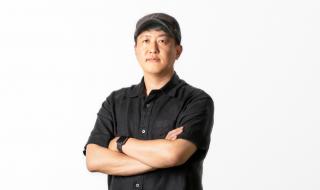
The Joy of Design
Bongyu Song, BKID Design Director/Launching Curator In the fall of 2023 in Seoul, there are many events taking place. I saw an article that said there are more than 40-50 pop-up stores per weekend in Seongsu-dong. It is literally the age of pop-up stores. Many brands are trying hard to make their presence known, whether it is to introduce new products or to promote their products. Unlike traditional fixed stores, these are limited-time events, lasting as little as a day or as long as a few weeks, but that limited time is what makes people come to pop-up stores. It's also a fun way to visit Seoul. Recently, I have taken up gardening as a hobby. I've been planting crops, starting seeds, and experiencing the trials and tribulations of being a beginner gardener in my 50 square meters of space. When I go into the gardening community to do research and ask questions, I find that people are enjoying gardening in a lot more ways than in the design community. Whether it's on a desk at work, on an apartment terrace, or on the roof of a house, there's always an amateur gardener with a small pot and a plant in some sort of airy, well-drained space. The gardening community shares the joy of gardening by exchanging tips on how to cut branches for planting, at what angle to cut them, and what kind of soil to use for planting. It was so much more free and fun than the design community and design-related events, which often share very realistic information such as job information and about qualifications, how to win design awards, and design as an industry. I felt so envious of the small warm interaction of sharing the small pleasures of gardening that can be enjoyed in your spare time. For us designers, is design a tool to compete for survival as a profession/industry, or can it be a culture that can be enjoyed?In the current design scene in Seoul, designers are questioning whether they are enjoying, communicating, and enjoying the pleasure of designing together, and as an indicator of industry, design is often evaluated by quantitative measures. Design can be a genre of culture, like film or art, or it can be a collaborator to help other industries/cultures grow. As designers, we may have to use design as both a profession to make a living and as a culture for pure enjoyment.
2023-10-18177 -
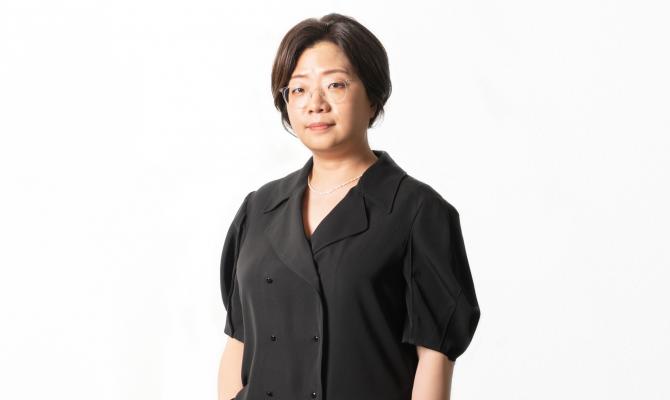
Design to Reflect Your Lifestyle
Oh Se-eun, Head of Furniture & Home Decoration, Lifestyle Division, Lotte Department Store/Launching CuratorI'm not an expert on the design industry, but having worked as a buyer in department stores for many years, I can tell you that the word design means a lot more in retail than it did when I started. I think that 10 years ago, if you were buying furnishings for newlyweds in a department store, you were almost always choosing a brand based on a recommendation from your mom or a friend who had gotten married first, so you were shopping within a narrow set of options, and the associated sales tended to be concentrated around those brands. But as time has gone on, people have become more and more likely to choose a brand or a product assortment based on their own preferences, and the idea of mega-trend, wedding-specific brands is becoming less and less common. And we're seeing this across all product categories, not just newlyweds. How has the meaning of brand and design changed in the face of increasingly diversified and personalized customer choices? I think people who used to be looking for a brand that was recognizable to others are now looking for a brand that expresses them and the design and story of the brand and the product are the most important criteria for that choice. Customers who find a design that fits their lifestyle and values, and a brand story that resonates with them, become passionate advocates for the brand and its products. In response to this change in customer behavior, the interior design of branded stores that once looked similar have been transformed into spaces that showcase the brand's concept and story, becoming an important marketing element.Previously, department stores were a place with “100 things” and their central concept was products, but now it seems that they should be a space with various designs and stories that can express the “100 lifestyles” of customers.
2023-10-11166 -
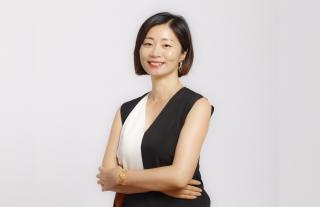
The Power To Sustain the Planet and People
An Kangeun, CEO of INNE Art Management/Collaboration CuratorThe world's leading contemporary art fair recently returned to Seoul, and it was even bigger and better than last year. Following in the footsteps of Paris, Miami, London, Basel, and Hong Kong, Seoul has come to expect a huge influx of domestic and international visitors every year during the fair. Artists, galleries, collectors, members of the art community, and the general public are expected to flock to the fair this year because it's a brief window of opportunity to see world-class artworks ranging from millions to billions of won in one place. However, there is also a sense that to many people on the other side of the fence, it can be seen as “beautiful trash”. Just as Banksy's billions of won a piece painting on the windows of a ruined building had an owner who destroyed the house because he thought it was just graffiti, how many works at this art fair will be preserved through the ages with a true understanding of the value of the artwork and the inspiration and comfort that art can bring to people? We live in an era where AI is building homes and clothes, treating and educating people, and even classifying, recognizing, predicting, and creating works of art. User-centered design, ethics and fairness, visual and interaction design, performance and efficiency optimization, continuous improvement, ethics and fairness... these are the principles of AI design, and we want AI systems that are trained based on exhaustive data in a way that minimizes bias and respects diversity to have a positive impact on users and society. At this point, I wonder, while the new paradigm of AI will bring an endless amount of art, industry, and so on, what is the alternative to AI for the global tropics, where the temperature is predicted to rise by more than 4 degrees in 7 years? Could many of those principles really be data reflecting the ecosystems of half the planet that may disappear in seven years?Will we still be in the same rush to create and consume "beautiful trash" as we are now? What is the irreplaceable thing that designers and small business owners can do in the new era that AI will usher in?The answer I thought of is communication, collaboration, and know-how. I hope they will eventually become our goals and obligations to sustain the planet and humanity. I hope we don't repeat the contradictions that have created so many tumblers and eco-bags in the name of environmental protection. Some of the richest and most powerful people in the Middle East are investing trillions of dollars in research to extend human life. It makes me ask more seriously, what does it mean to live another 200 years with trillions of “beautiful trash” on a planet that has become a sea of fire and water?
2023-10-07196 -
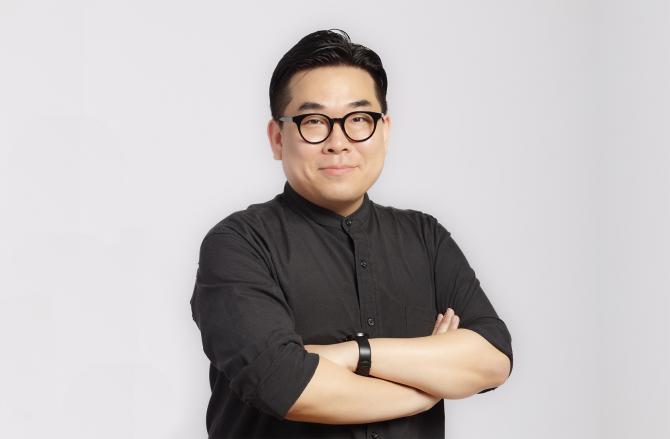
The romanticized view of sustainability
Eunhwan Cho, Co-CEO of Maezm/Collaboration CreatorWith the focus on sustainability in design having never been greater, as a participant and mentor at the DDP Design Launching Fair, there are a few things I've come to realize. One of them is that most designers and makers equate sustainability with eco-friendliness. This naturally influences their desire to incorporate sustainability into their work, focusing their attention on the materials used in production and the disposal of their designs afterwards. While this is certainly a desirable development, I often find myself having the same conversations over and over again, and my resistance to a one-size-fits-all approach often leads to a sense of resentment. As a result, I often find myself asking my mentees if there are other ways to think about and express sustainability. This may be me being perverse because we're all talking about the same thing, but it's also because there's only so much you can do about the production and post-processing of environmentally friendly materials if you're not a developer. It also makes me think about how effective these attempts will be in the context of a larger global movement, or whether they will end up producing something unnecessary again. I realize that there's a danger that this mindset will eventually boil down to "I’m just one person" but from my perspective, it's a hard battle to lose.This brings me to a story I shared with students in a graduate school class of mine last semester. Someone lamented that the tumblers they bought for the environment were accumulating at home, and that they didn't like drinking from paper straws because it felt like they were drinking from a wet cardboard box in their mouth. I jokingly remarked, "Come to think of it, you're probably emitting more carbon by bemoaning that unpleasant sensation than you're helping the environment by using paper straws." Then, a few days later, I picked up a paper straw to use for my coffee and thought to myself, "The paper must be coated to make it so smooth and hard, so is this paper 100% environmentally friendly?" And soon after, the news was full of studies from overseas showing that paper straws have harmful effects on the body, or are not even recyclable due to the coating process and added chemical compounds. It's still hard to say for sure, but it's hard to deny that many of the environmental issues we're so interested in and swept up in have a different story behind them.On that note, I personally recommend that sustainability be understood in a more romantic way, rather than in terms of big, analytical things like ingredients and circularity. Rather than being a movement that everyone should rally behind, sustainability can be seen as a romantic, personal, and private endeavor, which can be more meaningful in its own right. Keeping and loving personal items purchased long ago. It's about taking good care of the things you're attached to and passing them on to your children. It's about looking beyond functionality and choosing things that will last, even if they're a little more expensive. When I buy something, I think about it for days before I bring it into my home, and sometimes I don't throw it away because of the time I spent with it and the memories I have of it. In the end, for us as designers and consumers, creating and keeping something that will become someone's antique can also be an aspect of sustainability.
2023-10-07183 -
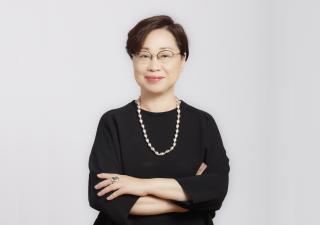
The final finishing touch to your space, lighting
Jeong Mee, CEO of EONSLD/Collaboration CuratorWhen I meet people for the first time and tell them I'm a lighting designer, they often ask, "Do you have any recommendations for lighting fixtures?". A lighting designer is a designer who engages in the act of designing spaces with light. When designing for lighting, they analyze the shape of the space, the finishes of the space, and think about how to make the space look with light, using lighting fixtures and lighting systems. Nowadays, lighting designers are often associated with architectural lighting and media facades, which have become more understood, but it's still an unfamiliar area of design. In the case of night landscape lighting, which is a design task that is visible to an unspecified number of people, the lighting designer analyzes the surrounding nighttime environment and creates a design concept, selects lighting fixtures, balances light, and designs how it will look at night. Nighttime landscape lighting often gives the façade of a building a different face from its daytime counterpart, creating an identity for the building. The lighting fixtures that we recognize as designer names and brands are often used as decorative features in interior lighting design. The role of light in interior spaces is to create a sense of space, to be functional for productivity, but most importantly, to be used as a finishing touch to a space. When the light is turned on and the space is illuminated, when the lights are turned off to go to sleep and the outside light is brought in, the space changes and takes on different expressions depending on the volume of light, the color of light, the shapes that are illuminated and the finishes that are reflected. When we design a lighting fixture, one of the most common mistakes we make is to design a form without thinking about the space it will be placed in. As space and design trends change over time, technology evolves, and materials become more diverse, it is important to always make the necessary design changes so that when the fixture is placed in the space or illuminated, the design will be accepted and loved without feeling awkward. Lighting is the final touch in architecture, giving a space character. It brings subjects to life and forms brand identity.
2023-10-07166 -

Lighting Design Trends in the Public Sector
LIGHT.FAB CEO Jeong SeungmoonStreetlights will be the most common design service offered by public institutions such as cities or municipalities. Streetlights allow citizens to walk safely and vehicles to drive safely through streets lit up at night. Let's take a look at how the design of streetlights has evolved from the past to today. A person climbs up a ladder and cleans a street lamp. This is one of the scenes in the 1800's. At that time, street lights were lit with gas or oil. Next is a street lamp designed by the Spanish architect Antoni Gaudí. You can still see this at Barcelona Park. This street lamp gives off a yellowish flame when the light is on. You will be able to find old images taken of Seoul from the 1930s, but you will not be able to find streetlights in street photos until the 1950s. However, there were gas lights or incandescent light bulbs even during this period, so you would be able to find small security lights near cafés and around the streets. Streetlights began to appear on the streets of Seoul in the 1960s. If you look at photos from the late 1960s, you can see streetlights at the Gwanghwamun Square. You can also see street lights and traffic lights around Seoul City Hall. At that time, traditional yellow sodium lamps were used for streetlights. Such street lamps with yellow lights were installed in almost every area of Seoul. The first streetlights at the Gwanghwamun Square in the late 1960s continued to be installed until the 1970s. The street lamps you see at this time are Sejongno-type octagonal tapered poles. I call this Sejongno-type octagonal tapered pole an “immortal masterpiece”. The lamp was 12 meters high. It was very difficult to make a pole of this height with the technology at that time. In fact, this design came from a product supplied to Asia by Philips, a Dutch company, in partnership with a Japanese company. Street lamps modeled after this product have been used in Korea until now. Due the advancement of technology in 1980, the light color of street lamps changed from yellow to white. If you look at photos from the 1980s, you can see a design with a hole drilled under the street lamp. A lot of flying insects are attracted to the white-colored light. In order to prevent this, the lower part of the street lamp started to be opened. Plastic glass first appeared In the 1980s. The glass part of Sejongno-type street lamps has been replaced with plastic, but the overall design stays the same until the 1990s. In the 2000s, we started to see small changes in the design of lighting fixtures. Sejongno-type lighting fixtures were gone and colored lamp heads started to appear at the Gwanghwamun Square. As the 2000s come to an end, there was no major change in the lamp post, but a slight change in the head color. From 2010, we started to witness various changes in street lamps. The head shape of street lamps at the Gwanghwamun Square has been changed to a circular shape and other various shapes. Above all, the biggest change is that it has started to be replaced with LED lamps. Since the price of LED lamps is higher than that of conventional sodium lamps, 5 pieces, 6 pieces and 10 pieces of 25W modules were arranged in the lighting fixture in order to lower the price. Since then, lighting fixtures mounting an array of modules have spread across Korea. I've seen this modular system only in Korea. A lot has happened, such as supplying lighting for American stadiums, since the active development of module systems in Korea. The color of the lamp has also become more diverse. In the past, the range of color temperature was standardized at around 3000K, where the light appears yellow, but now, if you look at the streetlight lamps in the Gwanghwamun Square, their color temperature is maintained through a more diverse range at around 4000-4500K. Let's take a look at the current trends to see how streetlights will change in the future. First of all, if you go to the recently opened Seoul Botanic Park located in Magok, you can see many multi-pole style lighting fixtures. It has several heads attached, so it looks like a flower bud. In addition to the change in design, these days, many features are embedded in one pole, which is called a smart-pole. It is a system that installs security cameras, emergency bells, public Wi-Fi, speakers, etc. on street lamps all at once. Many features are installed on a single pole at once due to cost. How much does it cost to install a pole? A traffic light costs 25 to 40 million won while a street lamp costs about 10 million won. You might think it would not cost much to install a street lamp, but the actual cost is surprisingly high. Since the cost is high, features that used to be installed separately are installed all at once on a smart street lamp. The Seoul Metropolitan Government’s policy requires smart street lamps to be installed in parks. I think all systems will be converged like this in the future. Lighting seems to be a very difficult field for the general public with limited information available. Among them, the design of street lamps, especially in the public sector, is very exclusive. It is very difficult to acquire new customers. Lastly, I would like to offer some good information to those who are interested in this field or want to pursue this career. Please take a look at “Light and Building”, which is the world’s largest lighting exhibition held every two years in Germany. If you have a chance, I would like to recommend you to attend this exhibition and enjoy various experiences.
2022-12-02262 -
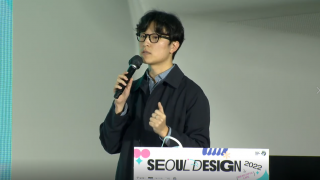
Sustainable Designs Through Collaboration
Design Studio Lim Sung Mook (DSLSM) Director Lim SungmookDSLSM, which started as a design agency in 2015, has developed its own technologies and patented designs in the startup industry. Just as we did 8 years ago, we are still striving to find an answer to the question: How can we realize the right values for us even 10 years from now? At first, as a creator, survival was our goal, but watching the process of products being produced, sold and discarded made me think about sustainable design. We intend to create sustainable designs by collaborating with various fields, such as creation, production, usage, environment, as well as the processes in between, including rights and structure, distribution, marketing, experience, disposal, needs and material. I will explain our work by comparing three models: a business model, a collaboration model, and our recent collaboration model. First, “sustainable designs through collaboration”. Our main business is eco-friendly packaging for brands. Our main activities are creation and marketing, and we collaborate with others for materials and production. We collaborate with our clients due to the nature of “packaging”, which is a special category. Disposable products have become a major social issue. Although it has been suspended for a while, the Ministry of Environment has already announced a plan to gradually reduce disposable packaging, aiming for zero disposable at brick and mortar stores in shopping malls by 2022. In addition to such policy announcements, civic groups are continuing related protests. That's why we started to pay attention to packaging. Our mainstream revenue comes from brands. Our clients are stores that sell agricultural products, eco-friendly brands and government and public offices, which have no choice but to use eco-friendly products. We are willing to take things a step further and view all organizations, which intend to use packaging with new features and purposes, as potential clients. Our signature product is “Net Bag”, a sustainable shopping bag. The word net was used for the brand name for visual reasons, but this is because net in French also means “pure or flawless”. One of the most notable features of our packaging is that it is made from a pure single material without any other additives. This shopping bag, which is easy to sort and recycle, can be used for a variety of purposes, such as using it for its intended purpose or as a portable shower basket made from waterproof material. In addition, it is also being developed for other purposes through structural changes, so it can be used for fashion brands, cosmetic brands or cafés, etc. There were many companies that contacted us after seeing our Net Bag, but in eight out of ten cases we were not able to sign a deal. They responded saying: “Net Bag is great and fun, but our company wants a more plain and ordinary packaging.” So, we came up with a solution of using thermal bonding technology that does not require any adhesive or thread and offered this to some companies. As a result, we were able to manufacture it at a lower cost than using any thread or additive, and using a single material made it easier for users to sort and recycle it after use.Further applications include net bags, square shopping bags, bread bags and small pouches. In addition, we are steadily acquiring rights to make eco-friendly packaging, such as patents and design rights for design, weight distribution structure and production structure for thermal bonding. As a design studio, we also collaborated with a home and living brand last year. The home and living brand wanted to add new home décor items to its product line, and we wanted to show DSLSM's design capabilities in more diverse fields. So, we developed an incense holder using our signature net structure. We were able to create our net structure in metal through a single, simple processing step without any assembly or further processing. This simple, unique product that is easy to load was created through aluminum, brass and finishing touches. We designed an illustration for the packaging and put a QR code next to the illustration to provide a playlist that you can enjoy while burning an incense stick. Thankfully, it has been introduced across various channels. We also held an exhibition during the process, contributing to great results in the home and living category. The last thing I would like to introduce you to is a project carried out in 2022: design products created with upcycled plastic marble sheets. This time, as a small business material developer, we collaborated with three design studios. As we continued packaging production, a lot of by-products were created during the process. We made it a priority to show how to use the by-products that are constantly created during the process. The first product is a table created in collaboration with Studio Pesi. To overcome the limits of processing in terms of size, the product was developed by finding a solution which can be applied to tables and various fields. The second product is a chair created in collaboration with Studio Tropique. Tropique is a studio that specializes in handmade furniture and interior design. It participated in the material bending process. We also bought a large toaster for restaurants to create effective bending that provides heat evenly from front to back. The last product is a furniture design created in collaboration with interior studio SPTL. We tried to combine the upcycled sheets more effectively and easily for easier display. It used upcycled sheets as frames while showing clean-cut edges of glass. The main focus of the overall process was to realize the value of sustainability. As such, our goal is to show a complete zero loss through production from eco-friendly packaging to by-products to furnishings. Lastly, if you ask us, “What is a sustainable design through collaboration?”, I will reply with two words: “focus” and “respect”. This is because we “focus” not only on what we are good at, but also on what we should do, and pursue collaboration based on the “respect” and trust we have for the people we work with. DSLSM will continue to realize the right values for us even 10 years from now.
2022-12-02239 -
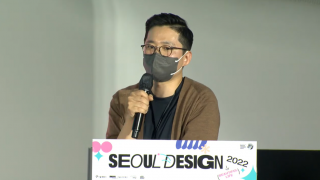
The Shift from User-centric to Manufacturing-based Perspective
LAB. M. 0 CEO, Maezm Co-founder Shin Taiho“User-centric” is the most trending topic in the design industry of the 21st century. The user is the main focus of the user-centric design methodology. So, the focus is on the user's experience. Functionality can be a very important factor to create a satisfying user experience. However, the focus on functionality caused many problems. The recent trend of sustainability raises a question: Is it right to focus on the user’s functions? So today, I would like to introduce the material-driven design methodology. It can be said that material, which had been considered during the last stage of manufacturing, now comes before planning and leads the overall design methodology. Our company name is M.0 (Material Zero-base). It means to see materials with zero (0) base. We do research on materials and translate research findings into products. We are making home and living products with alternative sources of energy, including biofuel, instead of new plastics made from petroleum. I will explain based on our design results. One of them is our company's most recent product, a tumbler. It looks like an ordinary cup, but when you look at the bottom, you can see the unique characteristic of this product: “from wood to ground”. It is made from a wood-based biomaterial, which completely returns to nature after disposal, but can be used as ordinary plastic. In other words, it is a product that slowly decays and disappears. It is called Reet Cup. Reet comes from the English word tree by moving the letter t to the back of the word. We wanted to convey the message that our product can return to nature and become a tree again. To explain a little about our material, it all boils down to the difference in molecular weight. Plastic is a polymer material with high molecular weight, so the molecules are heavy. The molecules hold each other more tightly, making it difficult to break a group of molecules linked together. The molecular weight of Reet Cup is almost one-fourth of that of plastic, which is similar to that of wood. So, it takes 20-30 years to decompose. Our brand philosophy is to tell more diverse stories behind what is visible on the surface of the product. That is why our brand name is Unroll Surface, which means to “spread the surface”. It is intended to rethink plastic materials that we have taken for granted by looking at the material beneath the surface. Our next product is made from recycled plastic, which is commonly called PCR plastic. Once thrown away and sorted, plastic will be shredded into flakes. The plastic flakes are melted and turned into small granules. The reason why we convert them to granules is to make them suitable for injection molding. When various kinds of plastic pieces are melted and mixed together, a gray color is created. Another additive is required to get a true white color, so we call this gray the new white. This product is an organizer that can be used to store pens or small items on a tray. It has a dull gray color since it is made from recycled material, but its variety of uses outweighs this disadvantage. And, the next product I would like to introduce is a stone made from recycled plastic. This product is commonly referred to as paperweight. We collect plastic materials from discarded products, crush them into flakes and compress them into large panels. Then, they are processed by a CNC cutting machine and manufactured into products, such a paperweight. If you take a closer look, their surface is not smooth or neat. They are not even uniform in shape. Since they are made from recycled material, a mixture of various kinds of materials, they are inevitably different from petroleum-based plastics. However, this is considered as an advantage instead of as a drawback. Their natural pattern and texture properties diminish the artificial feeling of plastic. What comes next is a product which uses felt made from recycled PET bottles. The first product is a pen tray. As it is made of soft felt, you can style your own space on your desk with this pen tray. PET bottles can be a high-quality material when they are well collected after use. Seoul city currently collects and recycles transparent PET bottles separately. The collected PET bottles are shredded into flakes. They are melted and processed into granules, also known as pellets, and then are melted again and spun into thin threads. Unfortunately, only 10% of fibers are used to make clothes in the industry, and we want to develop them into more useful products in our daily lives. We are currently developing various products other than pen trays. I would also like to introduce one of our collaborations. It is a set of a cute flower pot and trowel with Snoopys on them, which is developed by Unroll Surface in collaboration with Snoopy Garden. It used a plant-based plastic material called PLA, an example of biodegradable plastics. It is made of cellulose that exists in nature, such as corn starch or seaweed, and can be easily degraded by microorganisms. We went through a lot of difficulties during the production process, but in the end, we were able to acquire a care certification from Snoopy headquarters for the first time in the world. The source of our various stories about plastic we have talked about so far is the magazine we published called “Matter”. Matter, which means substance, is the origin of the word material. Interestingly, it comes from the Latin word for “mother”. The magazine does not provide technical knowledge about materials, but tells stories of the world viewed through the lens of materials. Plastic was selected as the first material and theme for the magazine. Our company was established with the aim of creating “sustainable materials and products to improve the natural environment and our living environment”. To realize this, our research institute researches materials, our brand — Unroll Surface — presents a lifestyle based on sustainable materials and products, and we create content that tells the stories of the world centered on materials. In line with the material-driven design methodology, we will continue to make efforts to create sustainable designs by prioritizing “material”, which had been considered as a factor for the stage of manufacturing and not considered as important factors, such as users, uses and functions, in various business fields.
2022-12-02218







